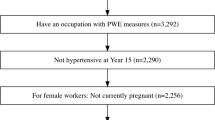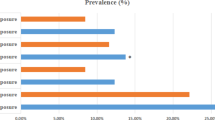Abstract
In this review I try to summarize concisely available information on common effectors on blood pressure, occupational, and environmental ones, which are sometimes overlooked, so that clinicians involved in caring for patients with hypertension may have somewhat better vision of what our patients are exposed to.
This is a preview of subscription content, access via your institution
Access options
Subscribe to this journal
Receive 12 digital issues and online access to articles
$119.00 per year
only $9.92 per issue
Buy this article
- Purchase on Springer Link
- Instant access to full article PDF
Prices may be subject to local taxes which are calculated during checkout
Similar content being viewed by others
References
Leiba A, Baur DM, Kales SN. Exercise-induced hypertension among healthy firefighters-a comparison between two different definitions. J Am Soc Hypertens. 2013;7:40–5.
Rosenthal T, Alter A. Occupational stress and hypertension. J Am Soc Hypertens. 2012;6:2–22.
Osório C, Probert T, Jones E, Young AH, Robbins I. Adapting to stress: understanding the neurobiology of resilience. Behav Med. 2017;43:307–22.
Childs E, de Wit H. Regular exercise is associated with emotional resilience to acute stress in healthy adults. Front Physiol. 2014;5:161.
Stessman J, Cohen A, Hammerman-Rozenberg R, Bursztyn M, Azoulay D, Maaravi Y, et al. Holocaust survivors in old age: the Jerusalem Longitudinal Study. J Am Geriatr Soc. 2008;56:470–7.
Landsbergis PA, Diez-Roux AV, Fujishiro K, Baron S, Kaufman JD, Meyer JD, et al. Job strain, occupational category, systolic blood pressure, and hypertension prevalence: the multi-ethnic study of atherosclerosis. J Occup Environ Med. 2015;57:1178–84.
Melamed S, Fried Y, Froom P. The interactive effect of chronic exposure to noise and job complexity on changes in blood pressure and job satisfaction: a longitudinal study of industrial employees. J Occup Health Psychol. 2001;6:182–95.
Melamed S, Kristal-Boneh E, Harari G, Froom P, Ribak J. Variation in the ambulatory blood pressure response to daily work load-the moderating role of job control. Scand J Work Environ Health. 1998;24:190–6.
Landsbergis PA, Dobson M, Koutsouras G, Schnall P. Job strain and ambulatory blood pressure: meta-analysis and systematic review. Am J Public Health. 2013;103:e61–71.
Boucher P, Gilbert-Ouimet M, Trudel X, Duchaine CD, Milot A, Brisson C. Masked hypertension and effort reward imbalance at work among 2369 white-collar workers. J Hum Hypertens. 2017;31:620–6.
Kivimäki M, Pentti J, Ferrie JE, Batty GD, Nyberg ST, Jokela M, et al. IPD-Work consortium.Work stress and risk of death in men and women with and without cardiometabolic disease: a multicohort study. Lancet Diabetes Endocrinol. 2018;6:705–13.
Green MS, Schwartz K, Harari G, Najenson T. Industrial noise exposure and ambulatory blood pressure and heart rate. J Occup Med. 1991;33:879–83.
Cayir A, Barrow TM, Wang H, Liu H, Li C, Ding N, et al. Occupational noise exposure is associated with hypertension in China: Results from project ELEFANT. PLoS ONE. 2018;13:e0209041. https://doi.org/10.1371/journal.pone.0209041.
Fu W, Wang C, Zou L, Liu Q, Gan Y, Yan S, et al. Association between exposure to noise and risk of hypertension: a meta-analysis of observational epidemiological studies. J Hypertens. 2017;35:2358–66.
Rojek M, Rajzer MW, Wojciechowska W, Drożdż T, Skalski P, Pizoń T, et al. Relationship among long-term aircraft noise exposure, blood pressure profile, and arterial stiffness. J Hypertens. 2019;37:1350–8.
Daiber A, Kröller-Schön S, Frenis K, Oelze M, Kalinovic S, Vujacic-Mirski K, et al. Environmental noise induces the release of stress hormones and inflammatory signaling molecules leading to oxidative stress and vascular dysfunction-Signatures of the internal exposome. Biofactors. 2019;45:495–506.
Pamporaki C, Bursztyn M, Reimann M, Ziemssen T, Bornstein SR, Sweep FC, et al. Seasonal variation in plasma free normetanephrine concentrations: implications for biochemical diagnosis of pheochromocytoma. Eur J Endocrinol. 2014;170:349–57.
Kristal-Boneh E, Harari G, Green MS, Ribak J. Seasonal changes in ambulatory blood pressure in employees under different indoor temperatures. Occup Environ Med. 1995;52:715–21.
Kristal-Boneh E, Harari G, Green MS. Seasonal change in 24-hour blood pressure and heart rate is greater among smokers than nonsmokers. Hypertension. 1997;30:436–41.
Modesti PA, Morabito M, Massetti L, Rapi S, Orlandini S, Mancia G, et al. Seasonal blood pressure changes: an independent relationship with temperature and daylight hours. Hypertension. 2013;61:908–14.
Di Pilla M, Bruno RM, Stea F, Massetti L, Taddei S, Ghiadoni L, et al. Impact of seasonality and air pollutants on carotid-femoral pulse wave velocity and wave reflection in hypertensive patients. PLoS ONE. 2017;12:e0172550.
Hanazawa T, Asayama K, Watabe D, Tanabe A, Satoh M, Inoue R, et al. HOMED BP (hypertension objective treatment based on measurement by electrical devices of blood pressure) investigators. Association between amplitude of seasonal variation in self-measured home blood pressure and cardiovascular outcomes: HOMED-BP (Hypertension Objective Treatment Based on Measurement By Electrical Devices of Blood Pressure) Study. J Am Heart Assoc. 2018;7:e008509.
Yang BY, Qian Z, Howard SW, Vaughn MG, Fan SJ, Liu KK, et al. Global association between ambient air pollution and blood pressure: a systematic review and meta-analysis. Environ Pollut. 2018;235:576–88.
Perez CM, Hazari MS, Farraj AK. Role of autonomic reflex arcs in cardiovascular responses to air pollution exposure. Cardiovasc Toxicol. 2015;15:69–78.
Bellavia A, Urch B, Speck M, Brook RD, Scott JA, Albetti B, et al. DNA hypomethylation, ambient particulate matter, and increased blood pressure: findings from controlled human exposure experiments. J Am Heart Assoc. 2013;2:e000212.
Miller MR, Newby DE. Air pollution and cardiovascular disease: car sick. Cardiovasc Res. 2019. pii: cvz228. https://doi.org/10.1093/cvr/cvz228.
Zhang M, Mueller NT, Wang H, Hong X, Appel LJ, Wang X. Maternal exposure to ambient particulate matter ≤2.5 μm during pregnancy and the risk for high blood pressure in childhood. Hypertension. 2018;72:194–201.
Brook RD, Rajagopalan S, Pope CA, Brook JR, Bhatnagar A, Diez-Roux AV, et al. American Heart Association Council on Epidemiology and Prevention; Council on the Kidney in Cardiovascular Disease; Council on Nutrition, Physical Activity and Metabolism. Particulate matter air pollution and cardiovascular disease: an update to the scientific statement from the American Heart Association. Circulation. 2010;121:2331–78.
Parati G, Agostoni P, Basnyat B, Bilo G, Brugger H, Coca A, et al. Clinical recommendations for high altitude exposure of individuals with pre-existing cardiovascular conditions: a joint statement by the European Society of Cardiology, the Council on Hypertension of the European Society of Cardiology, the European Society of Hypertension, the International Society of Mountain Medicine, the Italian Society of Hypertension and the Italian Society of Mountain Medicine. Eur Heart J. 2018;39:1546–54.
Green MS, Peled I. Differences in the prevalence of hypertension by ethnic origin and age at immigration in a cohort of 5146 Israelis. Am J Epidemiol. 1992;135:1237–50.
Peled A, Gordon B, Twig G, Grossman E, Matani D, Derazne E, et al. Hypertension and childhood migration: a nationwide study of 2.7 million adolescents. J Hypertens. 2019;37:702–9.
Rosenthal T. The effect of migration on hypertension and other cardiovascular risk factors: a review. J Am Soc Hypertens. 2014;8:171–91.
Bursztyn M, Raz I. Blood pressure, glucose, insulin and lipids of young Ethiopian recent immigrants to Israel and in those resident for 2 years. J Hypertens. 1993;11:455–9.
Reuven Y, Dreiher J, Shvartzman P. The prevalence of diabetes, hypertension and obesity among immigrants from East Africa and the former Soviet Union: a retrospective comparative 30-year cohort study. Cardiovasc Diabetol. 2016;15:74.
Bennet L, Nilsson PM. Country of birth modifies the associations of body mass and hemoglobin A1c with office blood pressure in Middle Eastern immigrants and native Swedes. J Hypertens. 2014;32:2362–70.
Lepoutre-Lussey C, Plouin PF, Steichen O. Cardiovascular risk factors in hypertensive patients born in Northern Africa and living in France. Blood Press. 2010;19:75–80.
Moran A, Diez Roux AV, Jackson SA, Kramer H, Manolio TA, Shragers S. Acculturation is associated with hypertension in a multi ethnic sample. Am J Hypertens. 2017;20:354–63.
Author information
Authors and Affiliations
Corresponding author
Ethics declarations
Conflict of interest
The author declares that he has no conflict of interest.
Additional information
Publisher’s note Springer Nature remains neutral with regard to jurisdictional claims in published maps and institutional affiliations.
Rights and permissions
About this article
Cite this article
Bursztyn, M. Occupational and environmental influences on hypertension. J Hum Hypertens 34, 202–206 (2020). https://doi.org/10.1038/s41371-020-0302-z
Received:
Revised:
Accepted:
Published:
Issue Date:
DOI: https://doi.org/10.1038/s41371-020-0302-z
This article is cited by
-
Genomics of hypertension: the road to precision medicine
Nature Reviews Cardiology (2021)



